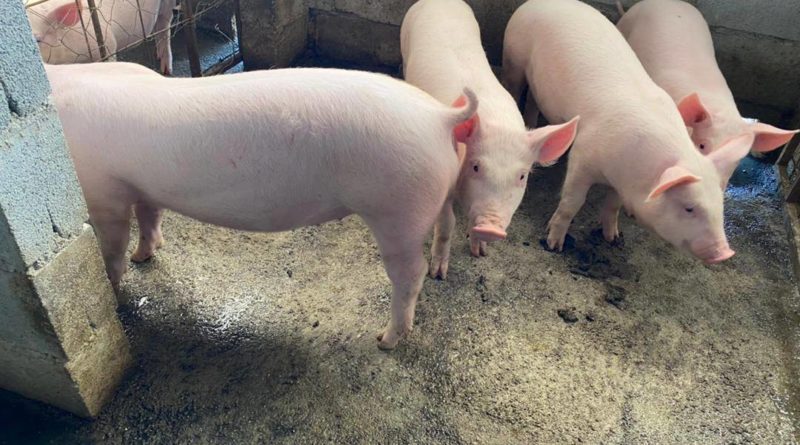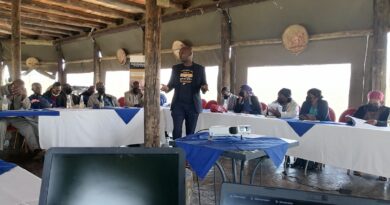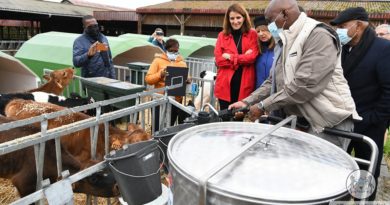Pig Production and Management
This article first appeared on Agribusiness
Pig production cycle
The life cycle begins with the piglets, which normally weigh 1.5-2 kg. In each birth event (farrowing), 8 to 12 piglets are born, although sows can produce litters of more than 20. Large litters have many small piglets, most of which may not survive; those that do may grow very slowly.
The piglets remain with their mother for 21 to 42 days, depending on the pig management practice of the farm. Piglets are weaned by removing the sow from the pen. Thereafter, they are fed formulated feed. After a few days of adjustment, the weaned pigs are kept in weaner pens for an additional 30 to 60 days until their weight reaches 20 kg. They are then moved into porker pens where they remain until they reach their market weight of 75-100 kg. The life span of a porker is anywhere from 150 to 230 days from birth to the abattoir. When slaughtered, the dress weight of the porkers is approximately 70% of live weight.
The main inputs in pig production are: breeding stock (gilts, sows, and boars); water for drinking and cleaning; feed (grains, protein supplements, minerals, and vitamins); preventive medicines and therapeutic drugs; housing and materials handling; management and husbandry; and sanitation, disinfection, and waste removal. Waste removal must be integrated with proper disposal in the environment, which means pollution control, resource recovery, and recycling. The pig production cycle can be divided into three phases: breeding, weaning, and growing/finishing.
Breeding
Breeding involves the mating of a sow or gilt (a female pig 5-7 months old that has not been bred before) with a boar, or artificial insemination. After conception, there is a gestation period averaging 114 days, during which the pregnant sows are housed in individual gestation pens.
A week before the sow is scheduled to deliver, she is moved into an individual farrowing pen. During the farrowing period, the animal requires special care and attention. The period from birth to weaning is called the lactation period. After the piglets are weaned, some of the best female weaners are kept as replacements for the sows. These animals constitute the herd of gilts.
Mating Period
The mating period lasts from the date of weaning the previous litter until the day of conception. During this time, the sow must be kept in a pen or a stall close to boars to stimulate estrus. Estrus is the cyclic period of sexual activity in female mammals. It is commonly called “heat” and is characterized by secretions, ovulation, and acceptance of the male.
The timing of the sow’s first estrus after weaning varies from 5 to 40 days. The conception rate for first service is normally about 80%. The estrus cycle of the sow is 21 days. In commercial pig production, it is desirable to reduce the number of days between farrowing and conception to produce more litters per sow per year. A high proportion of the sows that are in good physical condition will begin to come into heat 3-7 days postweaning. Adequate boar power is essential for effective synchronization of postweaning heat.
If a sow fails to conceive within 28 days postweaning, the farmer will cull her. This is enough time for her to have been bred twice. With each 21-day delay, the sow must produce two extra pigs just to pay for the time and feed she has consumed. Similarly, if gilts do not conceive after being bred three times, they are culled.
Gestation Period
The gestation period ranges from 110 to 120 days; 114 days is the average. During this period, the sow should be individually confined to prevent fighting with other sows and to restrict her activity and feed consumption. Individual stalls, rather than pens, are recommended to reduce embryo loss as a result of fighting. These gestation stalls may be the same ones occupied by the sow during breeding, or they may be located in another part of the barn. If there are separate facilities for breeding and gestating sows, then extra movement of animals is required. The choice of combined or separate breeding and gestation areas should be made by the manager when the farm is being designed.
Lactation Period
The lactation or suckling period of the sow begins when she farrows (i.e., gives birth to her litter of piglets); it ranges from 3 to 5 weeks. A long suckling period is not practiced in commercial production for economic and productivity reasons. Farrowing pens are the most expensive units to construct and, as such, need to be reused as often as possible. The nursing of large piglets weakens the sows, and thus affects their productivity and rebreeding.
Gilt Replacements
Immediately following the lactation period, old and unproductive sows are culled. These sows are replaced by young gilts. The number of gilts kept for breeding must be sufficient to replace those culled. Because the first estrus cycle of gilts is variable, it is recommended that one gilt be kept for every three or four litters farrowed. A gilt is considered a “replacement” gilt from the time her litter mates are sold for slaughter until she is bred at about 8 months of age. Replacement gilts may be housed in group pens or in stalls in the breeding barn. In either case, they are placed near boar pens to stimulate sexual development.
Most gilts reach puberty at 5-6 months. From this period on, the gilts will periodically show signs of “heat” (i. e., will stand to be mated to a boar). The estrus cycle will stop temporarily when the gilt is pregnant and start again after the sow has been weaned from her piglets. It is best not to mate the gilt in her first two heats. During these two heats, only a small number of eggs (ova) are produced; therefore mating would result in only a small litter. Moreover, at this stage, the gilt is still small and growing. Pregnancy might overly stress the animal, interrupt her growth, and result in difficulties in rearing the litter.
Weaning
When the suckling period is ended by removing the sow from the farrow pen, the piglets are called weaners. The demarcation between the weaner period and the grower/finisher period depends on the day of change in ration. Generally, piglets are called weaners until they reach 20 kg live weight at about 8 weeks of age.
It is customary to wean pigs from 3 to 5 weeks of age. If pigs are weaned at 3 weeks or younger they should weigh a minimum of 5 kg. Some reasons for seeking early weaning are to produce more than two litters per year from each sow; to take advantage of the high feed-conversion efficiency in young piglets; to produce heavier and more uniform grower pigs; to save on feed for sows because of the short lactation period; and to improve the welfare of the sow, which is neither overly stressed nor loses weight excessively during the short lactation periods. A survey in 1986 of the 10 largest commercial farms in Singapore showed that the mean weaning age was 27 days and the range was 20/30 days.
The period after weaning is the most stressful on the young piglets as they are taken away from the sow and forced to change from a milk diet to dry feed. Often, they are also moved to a new pen. The stress of feed change is lessened by starting the baby pigs on a prestarter dry feed while they are still nursing and by continuing them on the same diet for at least 1 week before changing to the starter ration.
Most managers move the piglets from the farrowing stall to weaner pens on the day of weaning. Some producers arrange the production schedule so the piglets can remain in the farrowing stall 3-7 days after weaning to further reduce stress. If this practice is to be used, then it must be considered in the planning phase of farm development because more farrowing stalls will be required. The disadvantage of this scheme is the additional cost for farrowing stalls and the extra space they require.
Feed for weaner pigs is normally a dry mash. Weaner pigs consume a daily maximum of 0.7 kg dry feed. On large farms, mechanical conveyors can be used to move the feed to pen self-feeders.
The weaner pigs are 8-10 weeks old when they are moved to the grower pen. After the pigs are moved out, the weaner pen should be thoroughly cleaned and left to rest for 3 or 4 days before a new batch is moved in.
Growing and Finishing (Porkers)
In commercial production, the last phase may be divided into the grower (up to 55 kg of animal live weight) and finisher stages (up to market weight). Growers are fed a ration that is high in protein; whereas fibre content is increased in the porker ration. Because growers are smaller than porkers, they require less space per pig and thus, there are economic savings in having two types of pens, but this means moving the pigs twice.



